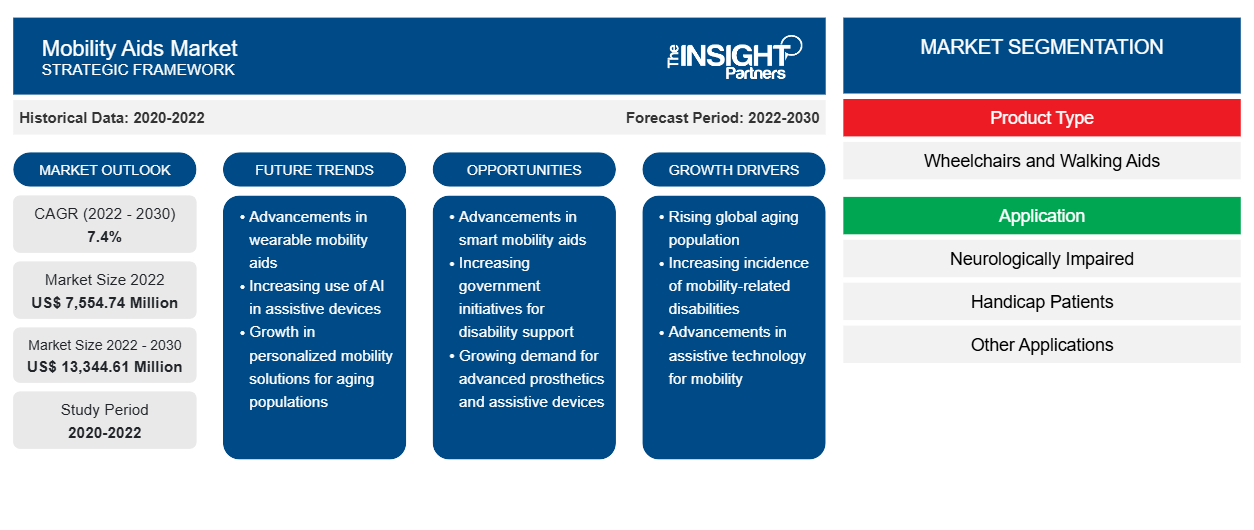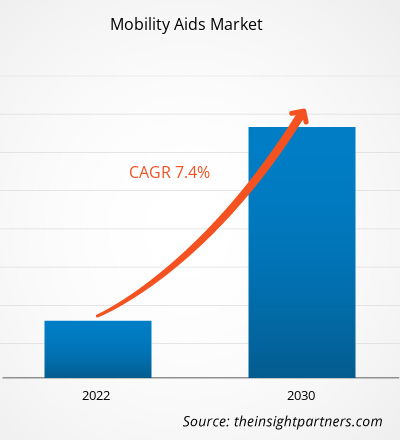[Research Report] The mobility aids market size is projected to grow from US$ 7,554.74 million in 2022 to US$ 13,344.61 million by 2030; it is estimated to record a CAGR of 7.4% during 2022–2030.
Market Insights and Analyst View:
A mobility aid is a tool that helps people with mobility issues walk; these aids can also be used by people to enhance their mobility. Mobility aids are made to make moving around easier for the elderly and disabled. Additionally, patients who have trouble moving around in their in-home care environments can be transported using these goods. Braces, canes, crutches, and walkers are a few examples of mobility aids. Walking aids include crutches, walkers, and assistive canes, commonly referred to as walking sticks. These devices can provide improved stability, decreased lower-limb burden, and/or movement generation, which help maintain upright ambulation.
Growth Drivers:
With age, people become more susceptible to mobility limitations, because of which they require medical assistance or aid to avoid dependency on other individuals. The worldwide population is aging rapidly, and the number of older adults is expected to increase significantly in the coming years. Most people expect to live into their sixties and beyond. According to a World Health Organization (WHO) 2021 study, the population of people aged 60 and above is expected to grow from 900 million in 2021 to 2 billion by 2050. The percentage of the global population aged 60 and above would almost double from 12% in 2015 to 22% in 2050.
According to the 2020 Census Bureau population statistics, the geriatric population reached 55.8 million (16.8%) of the total population of the US in 2020. The population of people aged 65 and above is predicted to surge from 2012 to 2050. Nearly 1 in 6 people in the country were aged 65 and above in 2020. As per the data published by the Fraser Institute, the share of the Canadian population aged 65 or older rose from 14% in 2010 to 19% in 2022, and it is further expected to reach 22.5% by 2030.
In Brazil, the aging population is increasing rapidly. According to the data from the Pan American Health Organization (PAHO), Brazil has over 30 million people aged 60 and above (i.e., 13% of the country's population). By 2030, the population of this age group is expected to reach ~50 million (i.e., 24% of the total population). As per the Brazil Statistical Institute, people aged 65 and above are expected to hold a 36% share of the total population of Brazil by 2050. Similarly, as per the Eurostat statistics, over one-fifth (~21%) of the European population was aged 65 and above in 2022.
The geriatric population often faces issues such as reduced muscle strength, balance issues, and joint problems, making it challenging for them to move around independently. These assistance devices such as walkers, canes, and wheelchairs provide support and assistance to them. These devices can reduce the risk of injuries, help prevent falls, and allow older adults to remain active and engaged in daily activities. Therefore, the rising geriatric population is driving the growth of the mobility aids market.
Customize This Report To Suit Your Requirement
You will get customization on any report - free of charge - including parts of this report, or country-level analysis, Excel Data pack, as well as avail great offers and discounts for start-ups & universities
Mobility Aids Market: Strategic Insights

-
Get Top Key Market Trends of this report.This FREE sample will include data analysis, ranging from market trends to estimates and forecasts.
Report Segmentation and Scope:
The mobility aids market is segmented on the basis of product type, application, end user, distribution channel, and geography. Based on product type, the mobility aids market is bifurcated into wheelchairs and walking aids. Based on application, the mobility aids market is classified into neurologically impaired, handicapped patients, and other applications. The mobility aids market, by end user is categorized into homecare, hospitals and clinics, rehabilitation centers, and ambulatory surgical centers. Based on distribution channel, the mobility aids market is bifurcated into online and offline. The mobility aids market, based on geography, is segmented into North America (US, Canada, and Mexico), Europe (France, Germany, UK, Spain, Italy, and Rest of Europe), Asia Pacific (China, India, Japan, Australia, South Korea, and Rest of APAC), the Middle East & Africa (Saudi Arabia, the UAE, South Africa, and Rest of MEA), and South & Central America (Brazil, Argentina, and Rest of South & Central America).
Segmental Analysis:
The mobility aids market, by product type, is bifurcated into wheelchairs and walking aids. The wheelchairs segment held a larger share of the market in 2022 and is expected to register a higher CAGR in the market during 2022–2030.
Based on application, the mobility aids market is segmented into neurologically impaired, handicapped patients, and other applications. In 2022, the neurologically impaired segment held the largest share of the market, and it is anticipated to record the fastest CAGR during 2022–2030.
Based on end user, the mobility aids market is segmented into homecare, hospitals and clinics, rehabilitation centers, and ambulatory surgical centers. The homecare segment held the largest share of the market in 2022. The hospitals and clinics segment is expected to register the highest CAGR during 2022–2030.
Based on distribution channel, the mobility aids market is categorized into online and offline. In 2022, the offline segment held a larger share of the market. However, the online segment is anticipated to grow at a higher CAGR during 2022–2030.
Regional Analysis:
The mobility aids market is primarily divided into North America, Europe, Asia Pacific, South & Central America, and the Middle East & Africa. North America captured a significant share of the market in 2022. In 2022, the US held the largest share of the market in the region. The market growth in North America is attributed to the rising number of patients diagnosed with mobility impairment disorders and the growing geriatric population. According to the UN Population Division, the population of elderly people in Mexico is anticipated to reach 30 million by 2050. According to the National SCI Data Sheet 2022, nearly 18,000 new spinal cord injury (SCI) cases are diagnosed yearly in the US. The 2023 United States Spinal Cord Injury Statistics state that ~302,000 people living in the country have suffered a traumatic SCI. In the US, the most common causes of SCI include vehicle crashes, falls, violence, and sports.
In addition, in March 2020, Invacare Corporation (US) launched the Invacare AVIVA FX Power Wheelchair with best-in-class design, technology, and performance. The AVIVA FX Power Wheelchair offers current front-wheel drive users a high-performance chair that is an innovative leap forward in front-wheel drive power mobility.
Mobility Aids Market Regional InsightsThe regional trends and factors influencing the Mobility Aids Market throughout the forecast period have been thoroughly explained by the analysts at The Insight Partners. This section also discusses Mobility Aids Market segments and geography across North America, Europe, Asia Pacific, Middle East and Africa, and South and Central America.
Mobility Aids Market Report Scope
| Report Attribute | Details |
|---|---|
| Market size in 2022 | US$ 7,554.74 Million |
| Market Size by 2030 | US$ 13,344.61 Million |
| Global CAGR (2022 - 2030) | 7.4% |
| Historical Data | 2020-2022 |
| Forecast period | 2022-2030 |
| Segments Covered |
By Product Type
|
| Regions and Countries Covered |
North America
|
| Market leaders and key company profiles |
|
Mobility Aids Market Players Density: Understanding Its Impact on Business Dynamics
The Mobility Aids Market is growing rapidly, driven by increasing end-user demand due to factors such as evolving consumer preferences, technological advancements, and greater awareness of the product's benefits. As demand rises, businesses are expanding their offerings, innovating to meet consumer needs, and capitalizing on emerging trends, which further fuels market growth.

- Get the Mobility Aids Market top key players overview
Industry Developments and Future Opportunities:
Various initiatives taken by key players operating in the global mobility aids market are listed below:
- In September 2023, Etac and Kalogon entered into a partnership to expand access to smart cushion technology for wheelchair users. The two companies joined forces to enhance Etac’s Star cushion product line powered by Kalogon’s revolutionary air management system.
- In March 2023, Stryker launched the SmartMedic platform, a patient care platform that enhances existing ICU bed capabilities at hospitals. This solution is intended to manage changes in patient weight, monitor patient turns from nurse stations, and help medical staff perform X-rays on patients within the ICU, without having to move them.
Competitive Landscape and Key Companies:
Invacare Corporation; Stryker Corporation; Medline Industries, Inc; NOVA Medical Product; Sunrise Medical LLC; Otto Bock HealthCare; Karman Healthcare; Carex Health Brands Inc.; Pride Mobility Products Corporation; and ETAC AB are among the prominent players in the mobility aids market. These companies focus on introducing new high-tech products, advancements in existing products, and geographic expansions to meet the growing consumer demand worldwide.
- Historical Analysis (2 Years), Base Year, Forecast (7 Years) with CAGR
- PEST and SWOT Analysis
- Market Size Value / Volume - Global, Regional, Country
- Industry and Competitive Landscape
- Excel Dataset
Recent Reports
Testimonials
Reason to Buy
- Informed Decision-Making
- Understanding Market Dynamics
- Competitive Analysis
- Identifying Emerging Markets
- Customer Insights
- Market Forecasts
- Risk Mitigation
- Boosting Operational Efficiency
- Strategic Planning
- Investment Justification
- Tracking Industry Innovations
- Aligning with Regulatory Trends





















 Get Free Sample For
Get Free Sample For